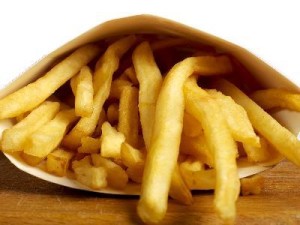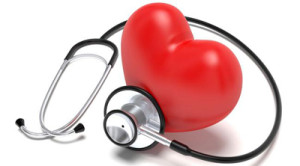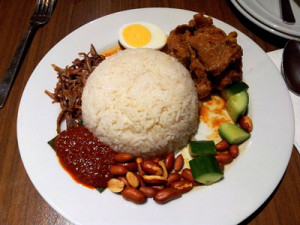“This product is trans fat free” it says on its label.
Trans fat free? What is that? Aren’t we supposed to worry on the amount of saturated fat we consume in our daily diet?
The word “trans” does not refer to the solubility property of the fat. That was how a non medical friend described it. Instead, “Trans” here describes the geometrical placement of the hydrogen atom in the fat molecule – the fatty acid. It is a type of unsaturated fatty acid. Yes, unsaturated fatty acids can be harmful to one’s health.
To make it easier to understand, vegetable oil appears in liquid form. Hydrogen atoms can be added to the vegetable oil through a process called hydrogenation. The placement of the hydrogen atoms takes the form of “trans”, in effect, the liquid oil will convert into a semi solid state. Here, it is only partially hydrogenated thus the name “partially hydrogenated oil”.
If hydrogenation is allowed to continue till there are no rooms for extra hydrogen atom to park, the fatty acid will become saturated – hence saturated fat.
Why use trans fat?
Historically, trans fat was used as shortenings. Trans fatty acid helps to prolong the shelf life of many food. That was the main purpose of hydrogenation when this process was patented. Furthermore, it is cheaper. It also improved the texture and the flavour of many processed food. It can be found in pastries (including the yummy doughnut), fried chicken, biscuit, pizza (think of roti canai) and even junk food that most Malaysian children savour. Prolonged deep frying can also produce trans fats.
Despite the tastiness of trans fat laden food that we indulge in daily, we have to acknowledge the chaos it creates in our body system. There are many studies that have leaned towards the deleterious effect of trans fat to our body system.
So, why should I be wary of trans fat?
The addition of trans fat in our diet adds on to our list of unhealthy risk factors that we are already burdened with. Trans fat is proven to reduce the HDL (a.k.a the good cholesterol) and increase LDL (the bad cholesterol). HDL is the single best lipid (fat) factor to predict the chance of one getting a heart attack. So, the lower the HDL, the higher the chance to get a heart attack.
Trans fat, by itself can cause damage to the cells lining our blood vessels. Imagine the trans fat as missiles continuously pounding an armoured bunker, which is the cell lining our blood vessels. The damage or “concrete rubble” as a result of that bombardment can occlude the flow of blood that supply our heart, thus enhances the risk of heart attack.
Trans fat has also been proven to render insulin, a hormone that regulates blood glucose levels, ineffective. As a consequence, trans fat is a risk factor that contributes to the development of diabetes. For those diabetics, especially obese diabetics, control of their sugar level just gets more difficult, even with medication.
However, trans fat also occurs naturally in our diet. It can be found in beef, mutton and dairy products. Bacteria in the cow’s digestive system hydrogenate oil from feed to turn it into trans fat. The effects of naturally occurring trans fat in our diet is still inconclusive. Certain studies report that natural trans fat increases HDL (the good cholesterol) level and reduces LDL (bad cholesterol) level. In some studies, small amount of natural trans fat does not have any effect on our body system. On the other hand, consuming large amount of natural trans fat may have the same deleterious effects as consuming artificial trans fat.
Until we are very certain, it is wise to avoid food containing trans fat at the moment. Since removing natural trans fat is improbable, reducing its intake looks like to be the only option.
Few countries in the world have started to realize the importance of restricting trans fat from their diet. Denmark is one of them. They were the first to set a limit to the amount of trans fat in food. The US have made it compulsory to declare the presence of trans fat in food if it is more than 0.5g per serving. In fact, food containing more than 2g of trans fat per 100g of lipid has been banned from the supermarket shelf.
Some countries have difficulty in trying to enforce trans fat free policy in their food. This is because the naturally occurring trans fat can still be present in food in minute amount. Food processing industries used this as their point of argument, by saying that only artificial trans fat can be removed. It is not possible to declare any processed food as trans fat free, when the natural trans fat can still be present. Some have argued that removing the natural trans fat from its natural source may even potentiate further unknown health effects.
Trans fat is one of the “nutrients” that does not have RDA or Recommended daily intake. WHO have recommended that the amount of trans fat intake should be lower than 1%. The lower the amount, the better it is. In fact, none at all is better.
In Malaysia, there is no law as yet to limit the amount of trans fat present in food. It is still not listed in the Malaysian Food Composition Database. Despite this, the Malaysian Ministry of Health have classified foodstuffs to have low trans fat if its content does not exceed 1.5g per 100 g lipid. A very recent study concluded that food in Malaysia generally has low amount of trans fat based on this guideline. The reason for this might be due to the extensive use of palm oil in the Malaysian cooking method. Palm oil is stable enough to prevent the formation of trans fat during food production. Although food in Malaysia generally has low content of trans fat, fried food, especially fried chicken and food that uses margarine such as roti canai contains relatively high amount of trans fat.
As consumers, there are simple ways on how to avoid our sinful indulgence of trans fat.
- Choose products that are trans fat free. This include products that contains “partially hydrogenated oil” listed in the ingredient. Partially hydrogenated oil means trans fat.
- Choose products low in saturated fat and cholesterol, preferably those lower than 5% of daily allowance. The lower it is, the lower your chance to consume trans fat.
- Use monounsaturated fat (olive oil, canola oil) or polyunsaturated fat (sunflower oil, corn oil) in recipes that calls for fat.
- Do not reuse cooking oils.
- Avoid food that possibly contain trans fat, especially when declaring the amount of trans fat is not yet implemented. As a general guide, avoid food with margarine, pastries or cookies, fast food (fries, fried chicken, burgers), frozen food (eg frozen pizza, frozen nugget, refrigerated dough products such as pau)
- Eat more fruits and vegetables, whole grain and meat with the skin and fat removed.
So, remember, before picking up the croissant or having your daily nasi lemak, think before it’s too late.
Dr. Helmy Hazmi is a community medicine specialist with a major in Epidemiology and Biostatistics in Science. He is currently working in his hometown, Kuching, as a medical lecturer in UNIMAS. Find out more in The Team page.
Sources:
- Akmar, Z., Norhaizan, M., Azimah, R., Azrina, A., & Chan, Y. (2013). The Trans Fatty Acids Content of Selected Foods in Malaysia. Mal J Nutr, 19(1), 87 -98. Retrieved October 10, 2013, from http://nutriweb.org.my/publications/mjn0019_1/8%20Norhaizan_Page%2087-98.pdf
- Mozaffarian, D., Aro, A., & Willett, W. C. (2009). Health Effects Of Trans-fatty Acids: Experimental And Observational Evidence. European Journal of Clinical Nutrition, 63, S5-S21.
- Mozaffarian, D., & Clarke, R. (2009). Quantitative Effects On Cardiovascular Risk Factors And Coronary Heart Disease Risk Of Replacing Partially Hydrogenated Vegetable Oils With Other Fats And Oils. European Journal of Clinical Nutrition, 63, S22-S33.
- Nishida, C., & Uauy, R. (2009). WHO Scientific Update On Health Consequences Of Trans Fatty Acids: Introduction. European Journal of Clinical Nutrition, 63, S1-S4.
- Skeaff, C. M. (2009). Feasibility Of Recommending Certain Replacement Or Alternative Fats. European Journal of Clinical Nutrition, 63, S34-S49.
- Uauy, R., Aro, A., Clarke, R., L’Abbé, M. R., Mozaffarian, D., Skeaff, C. M., et al. (2009). WHO Scientific Update On Trans Fatty Acids: Summary And Conclusions.European Journal of Clinical Nutrition, 63, S68-S75.
[This article belongs to The Malaysian Medical Gazette. Any republication (online or offline) without written permission from The Malaysian Medical Gazette is prohibited.]



